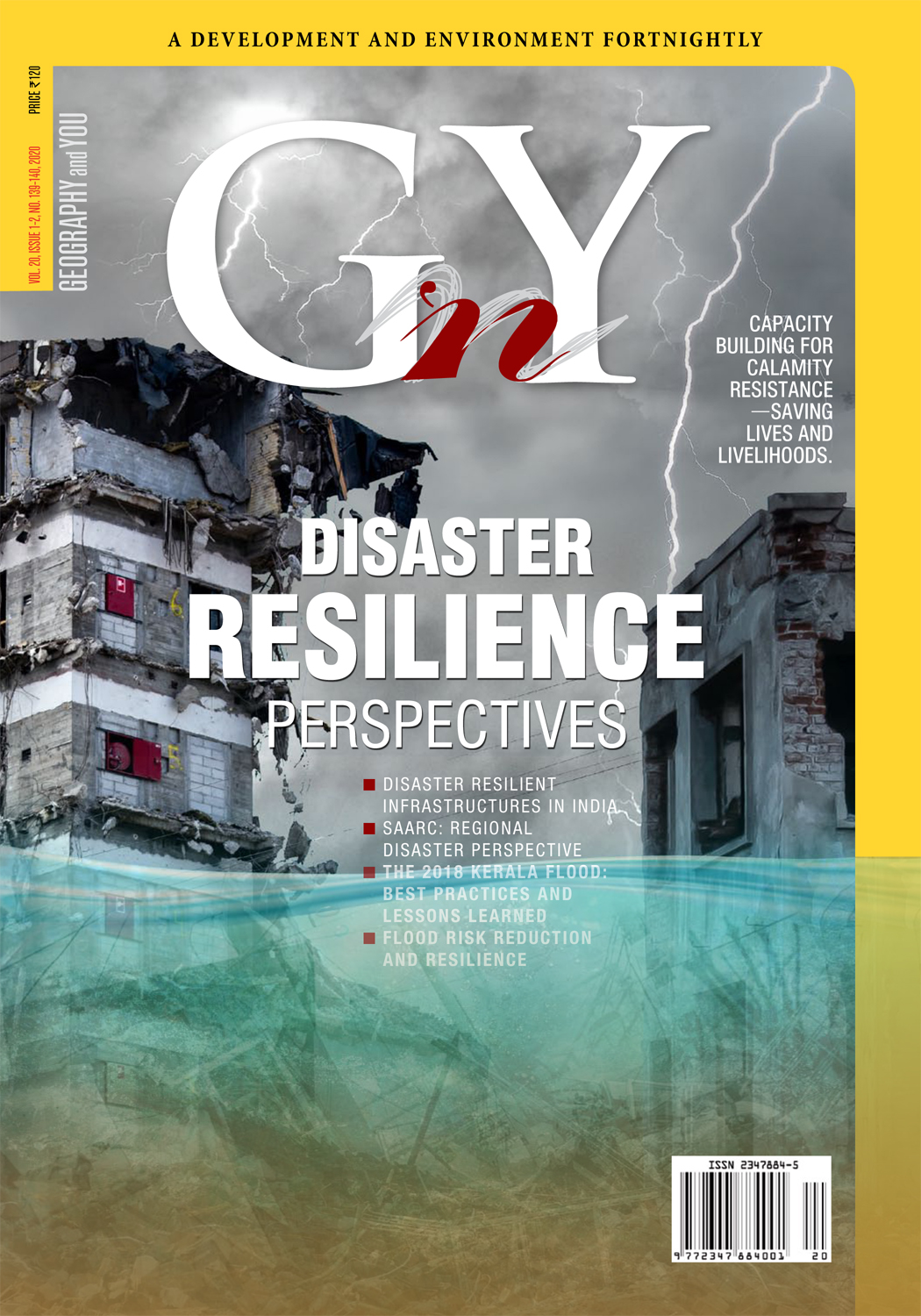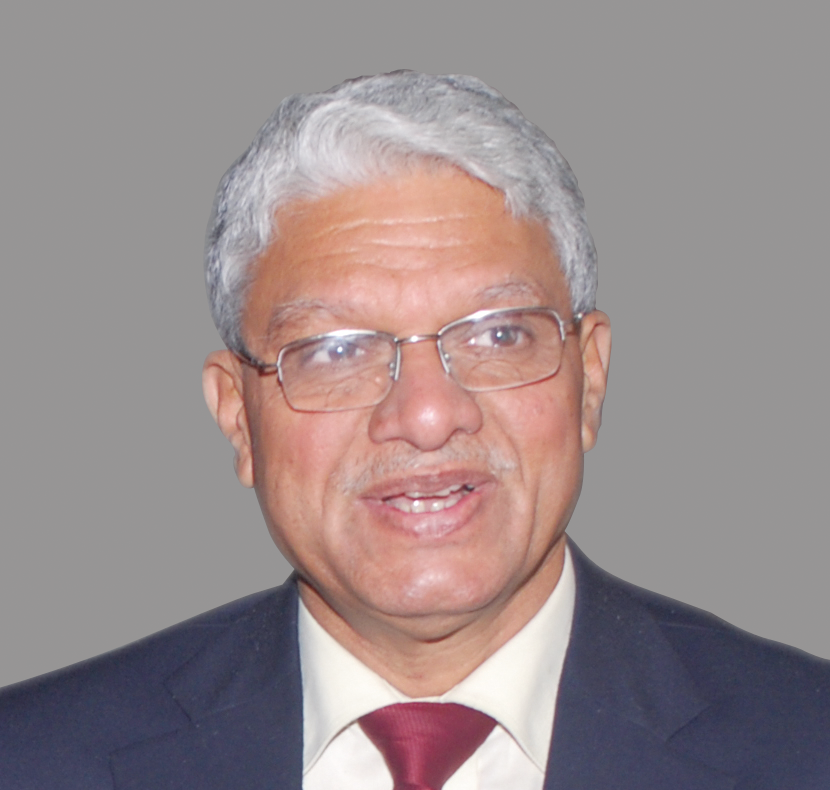
Expert Panel

Geologist and Secretary General, 36 IGC, New Delhi.

Former Professor, Jawaharlal Nehru University, New Delhi

Former Chairperson, National Biodiversity Authority, Chennai.

Former Vice Chancellor, MG Kashi Vidyapeeth, Varanasi

Air Vice Marshal (Retd) Former DG, India Meteorological Department (IMD), New Delhi

Former Director General, India Meteorological Department (IMD), New Delhi.

Former Professor, CSRD, Jawaharlal Nehru University, New Delhi.

Former Member Secretary, Central Pollution Control Board, New Delhi.
Inside this issue
DISASTER RESILIENCE PERSPECTIVES
Planning and implementing disaster risk reduction requires integration pathways and appropriate tools. The transition from Hyogo Framework for Action to the Sendai Framework for Disaster Risk Reduction has brought focus on specific goals, integrating climate change adaptation and environment-disaster linkages—mainstreaming it across all developmental sectors. This paper examines emerging issues of research and strategies for disaster risk framework strengthening and network development to achieve the designated goals by 2030, as also envisaged under the Prime Minister’s 10 Point Agenda on Disaster Risk Management.
Disasters have been inflicting heavy damage in terms of deaths, injuries, destruction of our habitat and economic activity. While over the last two decades India has much to share about its successful response in terms of minimising life loss—infrastructure damage however, have remained very high. The economic impact of these extreme events are required to be evaluated, particularly in the light of growing urban and coastal establishments of the country. Citing case studies of vulnerable built up facilities, this article presents disaster resilient infrastructure issues in India.
Coastal zones are facing multiple anthropogenic challenges, including the encroachment of water bodies, which hamper their flood resilience capacity. The recent floods in the coastal cities of Mumbai, Chennai and Kochi are examples. Even though India put in place the Coastal Regulation Zone (CRZ) Notification in 1991, its enforcement is a challenge. The recent Supreme Court order for the demolition of four high rise luxury apartment complexes in Kochi, which violated the CRZ Notifications, is an exception.
About 12 per cent of India's land is prone to floods. High intensity short duration rainfall; inadequate reservoir regulation; reduced channel carrying capacity; and, failure of flood management structures like levees and embankments exacerbate floods. Floods in northern, north eastern and coastal states of India cause considerable damage to lives, livelihoods, infrastructure, economy and the environment.
In a disaster prone country like India, it is important to work with multi-pronged strategy to reduce the risk of disasters. Proper supply chain management for disasters, which is known as humanitarian supply chain (HSC) can play a vital role in disaster risk reduction. HSCs are different than most commercial supply chains. But many qualities of commercial supply chains can help HSCs to be more effective. Handling of uncertainty, optimisation of facility locations, planning of inventory, developing proper information network are some of the issues, which HSCs can learn from commercial supply chains. At the same time commercial supply chains can also learn abilities to handle high uncertainty from HSCs. A properly planned HSC where the private sector is also involved can help in improving the response to the disasters.
It is imperative to reconnoiter the potential best practices, lessons learned and way forward from the Kerala 2018 floods, which include community response to disaster risk reduction and institutionalising capacity building for flood risk management. In order to support this review the significance of social capital in initial response as first responder and the need of institutionalising this social capital is critically analysed. The paper also suggests a way forward for flood risk reduction.
India is undergoing rapid urban expansion. With increasing population, rapid development and infrastructure growth, urban sprawls are the new hotspots of disaster. The article focuses on the Tier II city of Nagpur, which is being developed as a Smart City. The urban areas of the city have been facing recent water/climate challenges and it is pertinent to explore the future of this city in the backdrop of increasing urban disasters.
Research shows disasters exacerbate pre-existing vulnerabilities, which are often ignored in the disaster risk reduction policies. It is observed that people who are already vulnerable get more exposed to disaster risk, suffering a higher rate of mortality, morbidity and significant damages to their livelihoods and property. Although disasters do not make a distinction in gender—women and children tend to be the worst hit. The major global policy instruments thus need to align to facilitate and encourage better communication, participation and create awareness thereby ushering in the sustainable development goals under the 2030 development agenda. The paper attempts to highlight how streamlining disaster preparedness plays an important role in reducing vulnerabilities within and across communities.
The essay questions current development paradigms, which undermines community resilience. With climate change and increase in the frequency and intensity of disasters, sustainable living is imperative. There is an urgent need to stop indiscriminate development, which exacerbates vulnerabilities in communities.
The SAARC region, one of the global disaster hotspots, is prone to transboundary disasters. Analysis of available dataset shows that majority of the countries have been able to perform better in the terms of World Risk Index by improving their adaptive and coping capacities even though the exposure and vulnerabilities are higher. While on one hand the region lacks adequate resources, the SAARC member states have made significant progress in scientific research and disaster management which if shared collectively, can go a long way in making the region resilient to disaster risk.
IN CONVERSATION WITH
GVV Sarma, Member Secretary, National Disaster Management Authority, talks to G’nY about building multi-disaster resilient infrastructure through comprehensive and integrated guidelines by involving entire geographic and socio-economic ecosystems.
M Mohapatra, Director General, India Meteorological Department (IMD), talks to G’nY about successes in monitoring and prediction as also the associated challenges of climate related extreme events.
In brief
Building from experience: Community perceptions and gaps I recently visited a village in the Champaran district of Bihar in the midst of a cold wave and fell ill. The houses made of brick and mortar have large roshandans or a ventilators near the ceiling, which works well in the gruelling Indian s
A vicious cycle of people, property and potential damage It is alarming that climate and environmental risks have dominated the results of World Economic Forum’s (WEFs) annual Global Risks Perception Survey (GRPS). In fact, these risks accounted for three of the top five risks by likelihood—ext

